DACF Home → Bureaus & Programs → Maine Natural Areas Program → Communities, Plants, and Animals → Invasive Plants → Japanese stiltgrass
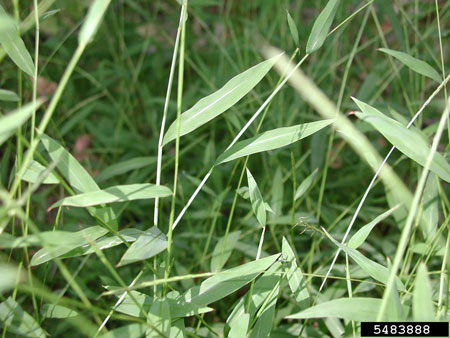 Japanese Stiltgrass, Leslie J. Mehroff, University of Connecticut, Bugwood.org
Japanese Stiltgrass, Leslie J. Mehroff, University of Connecticut, Bugwood.org
Japanese Stiltgrass
Stiltgrass
Microstegium vimineum
2019 Status in Maine: Localized. Severely Invasive.
Description: Herbaceous, annual grass, 1-3' tall, with a branching habitat. Plant resembles a small, delicate bamboo. Leaves: Alternate, pale green, ½" wide and 2-4" long with a stripe of reflective hairs on the midrib of the upper leaf surface. Flowers/Seeds: Flower heads develop late in the season (September) and contain 1-3 flower spikes, resembling crabgrass. Each plant can shed hundreds of yellow-reddish ellipticalseeds before dying in late fall.
Native range: Southeast Asia. How arrived in U.S.: In packing grass for Asian porcelain.
Reproduction: Produces new plants only by seed, which is viable 3-5 years. New shoots can grow from stem nodes during growing season.
Similar native species: Grasses can be difficult to identify without training. There are a number of species with either similarly shaped leaves or similarly shaped inflorescences as Japanese stiltgrass, but not both. Virginia cutgrass, also known as whitegrass (Leersia virginica), has both similar leaves and a similar inflorescence. However, Virginia cutgrass has a hairy ring around the stem nodes (vs. none on Japanese stiltgrass), and it lacks the shiny hairs on the leaf midrib.
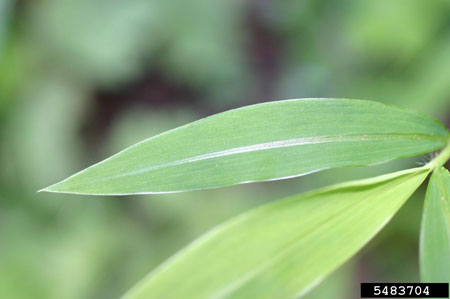 Reflective hairs along midrib of Japanese stiltgrass, Leslie J. Mehroff, University of Connecticut, Bugwood.org
Reflective hairs along midrib of Japanese stiltgrass, Leslie J. Mehroff, University of Connecticut, Bugwood.org
Similar non-native species: As with the native grasses, there are likely some species of non-native grasses with either leaves or inflorescences that look like Japanese stiltgrass.
Documented Ecological Impacts
- Japanese stiltgrass has potential to significantly alter soil chemistry. A greenhouse experiment showed a rapid rise in soil pH and available phosphorus, which may reduce diversity in soil and litter microarthropods. (McGrath, D.A. and M.A. Binkley. 2009. Microstegium vimineum Invasion Changes Soil Chemistry and Microarthropod Communities in Cumberland Plateau Forests. Southeastern Naturalist 8:141-156)
- Japanese stiltgrass may accelerate carbon cycling and deplete below-ground carbon pools in forests. (Strickland, M.S. et al. 2010. Grass invasion of a hardwood forest is associated with declines in belowground carbon pools. Global Change Biology 16:1338-1350)
- Japanese stiltgrass can strongly reduce native tree seedling regeneration and size, which may slow the rate of forest succession and alter tree species composition. (Flory, Sl.L. and K. Clay. 2020. Non-native grass invasion suppresses forest succession. Oecologia 164:1029-1038)
- Soil microbial communities in a hardwood forest invaded by Japanese stiltgrass were significantly different than in a non-invaded forest. (Kourtev, P.S. et al. 2002. Exotic plant species alter the microbial community structure and function in the soil. Ecology 83:3152-3166)
- Japanese stiltgrass has the potential to invade rare floodplain forests in Maine. Since these are rare habitats, invasions there are of top concern for conservation of biodiversity.
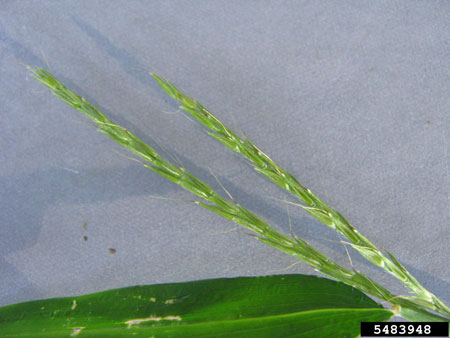 Flower spike of Japanese stiltgrass, Leslie J. Mehroff, University of Connecticut, Bugwood.org
Flower spike of Japanese stiltgrass, Leslie J. Mehroff, University of Connecticut, Bugwood.org
Fact Sheets and Identification Links
- Maine DACF, Invasive Stiltgrass in Maine Video (6:45)
- New Hampshire Department of Agriculture, Markets and Food, Division of Plant Industry Fact Sheet
- Pennsylvania Department of Conservation and Natural Resources Fact Sheet
- Southern Indiana Cooperative Invasives Management Identification Video (1:56)
- Go Botany page for Japanese stiltgrass
Control Methods
Plants are shallow rooted and easy to hand pull if the patches are small*. Mowing before seed set is effective (before August). Grass-specific herbicides† (clethodim, quizalofop, P-ethyl, sethoxydim) are very effective. Folar applications of glyphosate are effective. Imazapic is also effective in combination with glyphosate, but this should be used only via consultation with a licensed applicator due to the residual soil activity of this type of herbicide. Special rules apply to herbicide use in or near wetlands and water bodies - consult the Maine Board of Pesticides Control..
* Correctly dispose of all plant parts↵ † Follow all label directions when using herbicides↵Control Technique Links
- Penn State College of Agricultural Sciences, plant management guidelines.
- New Earth Landscaping video on control methods in turf settings (2:31)
- Wild Ones Louisville video on ecological impacts and control methods (3:14)
- The Woodland Steward video on ID and control in natural areas (14:40)
Please email invasives.mnap@maine.gov if you have questions about invasive species in Maine
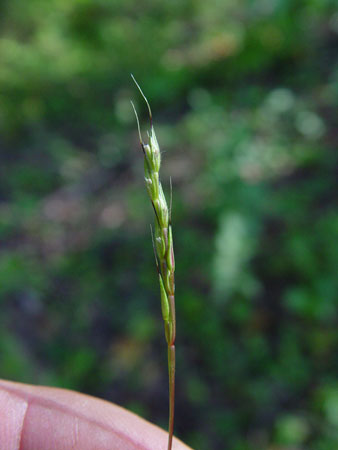 Flower spike of Japanese stiltgrass
Flower spike of Japanese stiltgrass
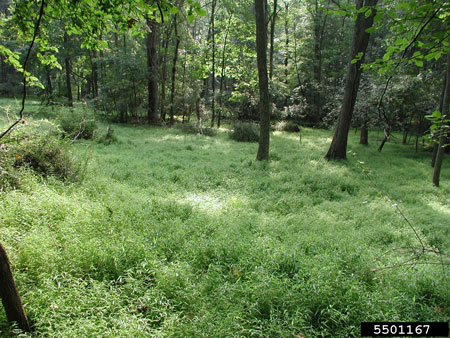 Japanese stiltgrass infestation, Leslie J. Mehrhoff, University of Connecticut, Bugwood.org
Japanese stiltgrass infestation, Leslie J. Mehrhoff, University of Connecticut, Bugwood.org